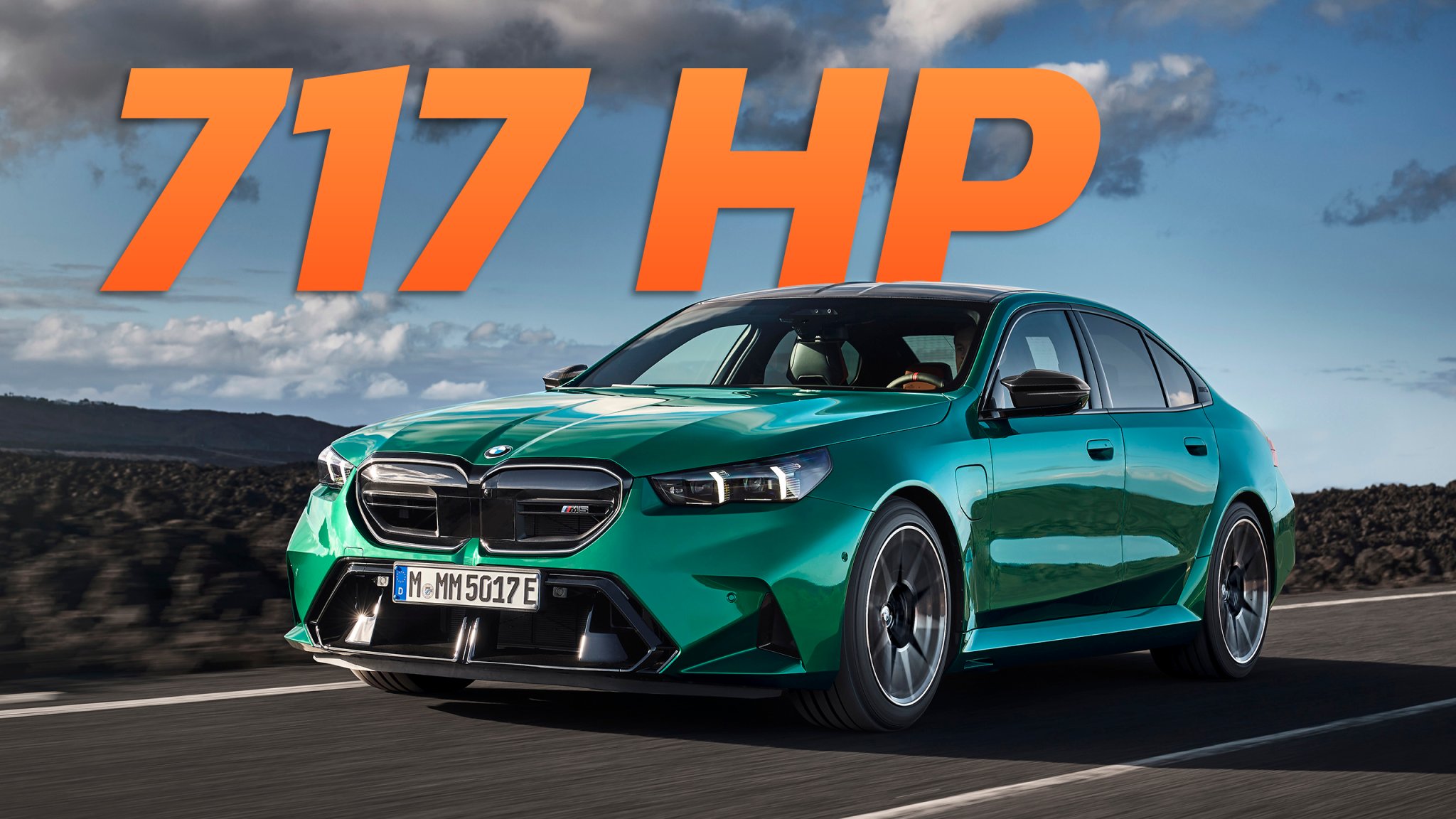

The seventh-generation M5 is here, people. As promised, the super sedan is now a plug-in hybrid, using what is essentially the same powertrain as the XM SUV. Pairing a 4.4-liter S68 twin-turbo V8 with a transmission-mounted electric motor, the 2025 BMW M5 makes 717 horsepower and 738 lb-ft of torque. That V8 itself makes 577 hp and 553 lb-ft, while the electric motor contributes 194 hp and 207 lb-ft.
This all translates to a top speed of 190 mph with the M Driver’s Package (155 mph is standard) but zero to 60 mph takes 3.4 seconds. That 0-60 time is objectively still speedy in the context of a big sedan but it’s notably slower than the outgoing, non-electrified M5, which hit 60 mph in 3.1 seconds in Competition form and 3.2 in base form (the hardcore M5 CS, meanwhile, did it in 2.9.) The reason for this is likely due to weight—the new M5 tips the scales at a massive 5,390 pounds. It’s practically 1,000 pounds heavier than the old M5, which was no lightweight itself.



Surely responsible for weight gain is that hybrid powertrain which BMW says is “closely related” to the M Hybrid V8 LMDh endurance race car the company takes to places like Le Mans. Electric-only range is said to be about 25 miles and the 14.8-kWh lithium-ion battery is located in the underbody for a low center of gravity. Engine and transmission mounts are specific to this car, while a new Boost Control function yields “instantaneous” speed when at traveling between 20 and 90 mph. A long pull of the downshift paddle puts the entire car into its most aggressive settings. Power travels through an eight-speed automatic transmission to all four wheels and gases are expelled through a new sport exhaust system.
The weight gained going hybrid may have hurt off-the-line acceleration, but BMW points to already-at-speed acceleration being an advantage of electrification, citing a 50-to-75-mph time of 2.2 seconds in fourth gear.




In any case, the new M5’s AWD system gets a lighter, more efficient transfer case than before while its Active M Differential can shuffle torque between the rear wheels however it likes. Just like with the last gen, the AWD system has three modes: regular 4WD, 4WD Sport (which directs more torque to the rear), and 2WD (which effectively turns it into a rear-wheel-drive car).
As with any new performance car, the body is stiffer than before, both longitudinally and torsionally. A bunch of strengthening beams have been added to the engine compartment including a shear panel between the strut towers. Rear underfloor braces are specific to M5, the aluminum double-wishbone front suspension has been made more rigid, and wheel carriers have been completely redesigned. The five-link rear axle uses its own bits, and it’s all said to contribute to this car’s ability to straddle handling and ride comfort. Adaptive M suspension is standard with electronic dampers including electromagnetically controlled valves that can adjust damping forces individually “in milliseconds.”
The power steering system is updated, featuring a variable ratio and speed-sensitive assist. M5 also now gets rear-wheel steering as standard at angles up to 1.5 degrees, giving it a smaller turning circle at low speeds but better stability and comfort at high ones. There’s a new integrated braking system and the car comes with M Compound brakes standard with lighter, stronger, and more durable carbon ceramics optional. Staggered wheels measure 20 inches up front and 21 inches in the back.





The M5, naturally, appears more aggressive from the outside. Bigger intakes up front and flared fenders on the sides make the seventh-gen look the business and, breaking out the tape measure, this car is 3 inches wider at the front wheels and 1.9 inches wider at the rear over the regular 5 Series.
The 2025 BMW M5 will start at $120,675 and is coming to Goodwood Festival of Speed in July, and dealerships in November. Of course, that wagon version is on the way, too. Stay tuned.
Got a tip or question for the author about the new M5? You can reach him here: chris.tsui@thedrive.com